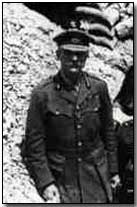Battles - The Second Battle of Krithia, 1915
 Following the
failure of the first
Allied attempt to capture the village of Krithia and its prominent hill
feature Achi Baba on 28 April 1915 a second attempt was initiated on 6 May.
Following the
failure of the first
Allied attempt to capture the village of Krithia and its prominent hill
feature Achi Baba on 28 April 1915 a second attempt was initiated on 6 May.
The Allied force used as the basis of the attack was sited at a beachhead on Cape Helles operating under British commander Aylmer Hunter-Weston. Some 20,000 troops had survived the landing at Cape Helles on 25 April but losses during the first attempt upon Krithia had reduced this total to just 14,000.
Facing Hunter-Weston in a 7km line in front of Krithia was an equivalent Turkish force overseen by attached German officer Liman von Sanders. Liman was acting under instructions from Turkish minister of war Enver Pasha to deny Hunter-Weston's force access to Krithia and Achi Baba, and with it the danger of evicting Turkish defenders from the heights overlooking the Dardanelles Straits.
To that end Enver had authorised Liman to respond to the Allied attacks of 28 April with counter-strikes of his own on 1 and 3 May. Both were however repulsed with heavy Turkish loss. The latter attacks were nevertheless an indicator of Enver's determination to resist further Allied advances north of Cape Helles.
 By the time Hunter-Weston
renewed the attack at noon on 6 May his force had been reinforced by two
Anzac brigades to a total of 25,000 men plus an additional 20 guns. He
could not however claim a numerical advantage over Liman whose force has
been similarly reinforced.
By the time Hunter-Weston
renewed the attack at noon on 6 May his force had been reinforced by two
Anzac brigades to a total of 25,000 men plus an additional 20 guns. He
could not however claim a numerical advantage over Liman whose force has
been similarly reinforced.
More critically, Hunter-Weston's ammunition shortage continued. Yet when the attack was launched of greater concern was the lack of command co-ordination which reduced the day's gains to a negligible few metres.
Hunter-Weston renewed the attack on the following day after a preliminary bombardment by the offshore fleet - with similar results. Once again little progress was made in the face of a continuing lack of command focus. Unrepentant Hunter-Weston attempted a third and final attack on 8 May, prefaced by a preliminary shrapnel bombardment using all available guns and shells (which did not in fact amount to much, shrapnel not greatly damaging the Turkish positions). Nevertheless real gains were made with the Turkish line pushed back by almost a kilometre.
Hunter-Weston's casualties were as usual high, with a further loss of 6,000 men. Although the battle had resulted in a degree of gain, the Achi Baba feature remained in Turkish hands. The Allied regional Commander-in-Chief, Sir Ian Hamilton, remained grimly determined to secure its capture and pressed war minister Lord Kitchener in London for a further 25,000 shells and four additional divisions. Kitchener's response was not encouraging and took three weeks to arrive.
 In the midst of the
so-called 'Shell Scandal' brought about by the British Commander-in-Chief on
the Western Front -
Sir John French
- Kitchener could ill-afford to redirect ammunition from the highest-profile
area of fighting to the Gallipoli 'sideshow'. Nor could he ultimately
offer more than a single division to bolster Hamilton's dwindling force.
In the midst of the
so-called 'Shell Scandal' brought about by the British Commander-in-Chief on
the Western Front -
Sir John French
- Kitchener could ill-afford to redirect ammunition from the highest-profile
area of fighting to the Gallipoli 'sideshow'. Nor could he ultimately
offer more than a single division to bolster Hamilton's dwindling force.
Fighting at Krithia was renewed on 4 June with the target once more Achi Baba. In the interim fighting on the Gallipoli peninsular took on the form of trench warfare similar to that seen on the Western Front, with the critical difference that the Allied force found it highly problematic to construct trench lines that were not readily accessible to Turkish shellfire.
To view maps detailing the progress of the Gallipoli campaign click here; and here; and here; and here.
Photographs courtesy of Photos of the Great War website
A "Communication Trench" was a narrow trench constructed at an angle to a defensive trench to permit concealed access to the defensive trench.
- Did you know?
